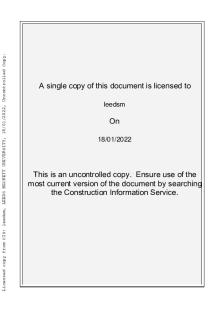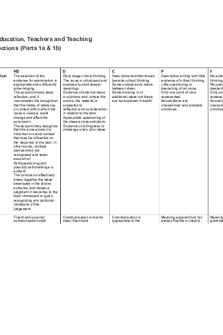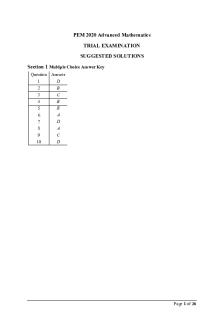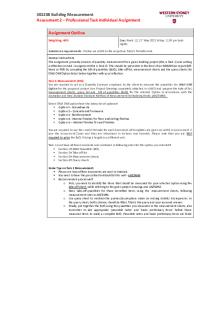EDUF1018 2020 Critical Reflections Marking Criteria PDF

| Title | EDUF1018 2020 Critical Reflections Marking Criteria |
|---|---|
| Author | Sunny Yu |
| Course | Education,Teachers and Teaching |
| Institution | University of Sydney |
| Pages | 2 |
| File Size | 83.6 KB |
| File Type | |
| Total Views | 146 |
Summary
Download EDUF1018 2020 Critical Reflections Marking Criteria PDF
Description
EDUF1018 Education, Teachers and Teaching Critical Reflections (Parts 1a & 1b) Marking criteria
HD
D
C
P
F
Demonstration of critical thinking
The selection of the evidence for examination is appropriate and sufficiently wide-ranging. The account shows deep reflection, and it incorporates the recognition that the frame of reference or context within which the issue is viewed, could change and affect the conclusion. The account may recognize that the issue exists in a historical or social context that may be influential on the response to the task. In other words, multiple perspectives are recognized and taken account of. Self-questioning and possibly self-challenge is evident. The conclusion effectively draws together the ideas developed in the text as evidence and makes a judgment in response to the topic introduced or given, recognizing any particular limitations of the judgement.
Early stage critical thinking The issue is introduced and explored to elicit deeper meanings Evidence of external ideas or opinions and, where this occurs, the material is subjected to reflection and consideration in relation to the task. Appropriate questioning of the ideas and assumptions. Evidence of willingness to challenge one's prior ideas.
Descriptive text that moves towards critical thinking. Some comparisons made between ideas. Some drawing in of additional ideas but these are not explored in depth.
Descriptive writing with little evidence of critical thinking. Little questioning or deepening of an issue. Only one point of view represented. Assumptions are unexamined and probably unnoticed.
No evidence of critical thinking. No questioning or deepening of an issue. Only one point of view represented. Assumptions are unexamined and probably unnoticed.
Clarity of expression (including accuracy,
Fluent and succinct communication style
Communication is mainly clear, fluent and
Communication is appropriate to the
Meaning apparent but not always fluently or clearly
Meaning unclear and/or grammar and/or language
spelling, grammar, punctuation, use of language, expression of ideas)
Referencing
appropriate to the assessment task. Grammar, spelling, use of language and punctuation is appropriate and accurate. Uses recommended referencing style consistently and accurately in text of work and reference list. Effective use of relevant quotations
appropriate to document. Grammar, spelling, use of language and punctuation is accurate.
assessment task and is mostly fluent and clear. Grammar, spelling, use of language and punctuation mostly accurate.
Uses recommended referencing style consistently and accurately in text of work and reference list. Effective use of relevant quotations
Uses recommended referencing style with minimal errors. Effective use of relevant quotations
communicated. Grammar, spelling, language and/or punctuation may display minor errors. Some evidence of applying School’s style guide Referencing is mainly accurate. Ineffective use of quotations
and/or spelling and/or punctuation contain frequent errors or is inappropriate. Does not reflect School’s style guide. Many errors or no use of conventions in referencing. Fails to meet University’s academic honesty policy....
Similar Free PDFs

Final Report Marking Criteria
- 1 Pages

Marking criteria - unknown drug
- 4 Pages

ECON 1145-Marking Criteria- May 2021
- 14 Pages

2020-hsc-biology- Marking Guidelines
- 17 Pages

UKCA Marking Marking of Steel
- 21 Pages

Marking rubric
- 1 Pages
Popular Institutions
- Tinajero National High School - Annex
- Politeknik Caltex Riau
- Yokohama City University
- SGT University
- University of Al-Qadisiyah
- Divine Word College of Vigan
- Techniek College Rotterdam
- Universidade de Santiago
- Universiti Teknologi MARA Cawangan Johor Kampus Pasir Gudang
- Poltekkes Kemenkes Yogyakarta
- Baguio City National High School
- Colegio san marcos
- preparatoria uno
- Centro de Bachillerato Tecnológico Industrial y de Servicios No. 107
- Dalian Maritime University
- Quang Trung Secondary School
- Colegio Tecnológico en Informática
- Corporación Regional de Educación Superior
- Grupo CEDVA
- Dar Al Uloom University
- Centro de Estudios Preuniversitarios de la Universidad Nacional de Ingeniería
- 上智大学
- Aakash International School, Nuna Majara
- San Felipe Neri Catholic School
- Kang Chiao International School - New Taipei City
- Misamis Occidental National High School
- Institución Educativa Escuela Normal Juan Ladrilleros
- Kolehiyo ng Pantukan
- Batanes State College
- Instituto Continental
- Sekolah Menengah Kejuruan Kesehatan Kaltara (Tarakan)
- Colegio de La Inmaculada Concepcion - Cebu









